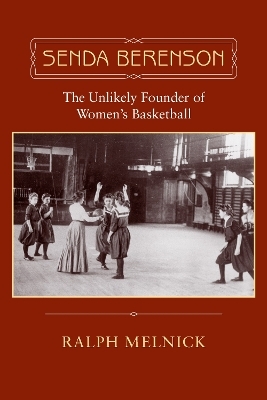
Senda Berenson
The Unlikely Founder of Women's Basketball
Seiten
2007
University of Massachusetts Press (Verlag)
978-1-55849-568-5 (ISBN)
University of Massachusetts Press (Verlag)
978-1-55849-568-5 (ISBN)
Points out that Senda Berenson's (1868-1954) pioneering role in the history of women's athletics was more a matter of accident than destiny. Senda Berenson and her brother, Bernard Berenson wrote frequently to each other over the course of their lives. Drawing on their correspondence, this book creates portrait of this remarkable American woman.
In the winter of 1892, the new instructor of physical training at Smith College, a diminutive young woman with a heavy accent, introduced her students to an adaptation of James Naismith's new game of Basket Ball. An immediate if unexpected success, the game spread to other women's schools across the country, and soon its founder, Senda Berenson (1868-1954), was called upon to codify its distinctive set of gender-specific rules. Emphasizing team passing and position over individual play, the version she instituted defined women's basketball for seventy years and eventually earned her the honor of being the first female elected to the Basketball Hall of Fame. Yet, as Ralph Melnick points out, Berenson's pioneering role in the history of women's athletics was more a matter of accident than destiny. A Jewish immigrant from Lithuania, prone to ill health throughout her childhood, she enrolled in the Boston Normal School for Gymnastics in the fall of 1890 with the hope of strengthening herself so that she could pursue a career as a pianist, dancer, or painter. Instead, she soon became both a practitioner and a proponent of a new approach to women's physical education, one aimed at providing a ""natural outlet of the play instinct,"" developing ""endurance and physical courage"" as well as ""quickness of thought and action,"" and promoting through team work the ""power of organization"" women needed to achieve full social equality. Extending her work into the factories and blighted urban tenements of America, Berenson later won the recognition of Jane Addams, Margaret Sanger, and other progressive reformers. Believing that ""Americans have forgotten how to play,"" she wanted to teach others to live ""joyfully - beautifully."" For Berenson, the physical culture of exercise and games, played not for competition but for personal and social development as well as sheer enjoyment, was but another form of art. This convergence of athletics and aesthetics was hardly surprising, Melnick explains, because the single most important influence on Senda Berenson's life was her brother, the renowned art critic and connoisseur, Bernard Berenson. The two siblings wrote frequently to each other over the course of their lives, and the author draws heavily on their correspondence throughout the book to create an intimate and insightful portrait of a remarkable American woman.
In the winter of 1892, the new instructor of physical training at Smith College, a diminutive young woman with a heavy accent, introduced her students to an adaptation of James Naismith's new game of Basket Ball. An immediate if unexpected success, the game spread to other women's schools across the country, and soon its founder, Senda Berenson (1868-1954), was called upon to codify its distinctive set of gender-specific rules. Emphasizing team passing and position over individual play, the version she instituted defined women's basketball for seventy years and eventually earned her the honor of being the first female elected to the Basketball Hall of Fame. Yet, as Ralph Melnick points out, Berenson's pioneering role in the history of women's athletics was more a matter of accident than destiny. A Jewish immigrant from Lithuania, prone to ill health throughout her childhood, she enrolled in the Boston Normal School for Gymnastics in the fall of 1890 with the hope of strengthening herself so that she could pursue a career as a pianist, dancer, or painter. Instead, she soon became both a practitioner and a proponent of a new approach to women's physical education, one aimed at providing a ""natural outlet of the play instinct,"" developing ""endurance and physical courage"" as well as ""quickness of thought and action,"" and promoting through team work the ""power of organization"" women needed to achieve full social equality. Extending her work into the factories and blighted urban tenements of America, Berenson later won the recognition of Jane Addams, Margaret Sanger, and other progressive reformers. Believing that ""Americans have forgotten how to play,"" she wanted to teach others to live ""joyfully - beautifully."" For Berenson, the physical culture of exercise and games, played not for competition but for personal and social development as well as sheer enjoyment, was but another form of art. This convergence of athletics and aesthetics was hardly surprising, Melnick explains, because the single most important influence on Senda Berenson's life was her brother, the renowned art critic and connoisseur, Bernard Berenson. The two siblings wrote frequently to each other over the course of their lives, and the author draws heavily on their correspondence throughout the book to create an intimate and insightful portrait of a remarkable American woman.
An independent scholar, RALPH MELNICK received a Ph.D. in the history of religion from Yale University. He is author of The Stolen Legacy of Anne Frank: Meyer Levin, Lillian Hellman, and the Staging of the Diary and Justice Betrayed: A Double Killing in Old Santa Fe, among other works.
| Erscheint lt. Verlag | 30.3.2007 |
|---|---|
| Zusatzinfo | 16 illustrations |
| Verlagsort | Massachusetts |
| Sprache | englisch |
| Maße | 152 x 226 mm |
| Gewicht | 395 g |
| Themenwelt | Literatur ► Biografien / Erfahrungsberichte |
| Sachbuch/Ratgeber ► Sport ► Basketball | |
| Sozialwissenschaften ► Soziologie ► Gender Studies | |
| ISBN-10 | 1-55849-568-1 / 1558495681 |
| ISBN-13 | 978-1-55849-568-5 / 9781558495685 |
| Zustand | Neuware |
| Haben Sie eine Frage zum Produkt? |
Mehr entdecken
aus dem Bereich
aus dem Bereich
die 365 besten Übungen
Buch | Softcover (2024)
Copress (Verlag)
24,90 €
Technik, Taktik, Training, Methodik
Buch | Softcover (2024)
Meyer & Meyer (Verlag)
32,00 €


